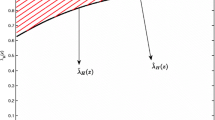Abstract
Due to the fact that a consumer’s willingness to pay differs between segments, many unregulated industries are price constrained, although the specific costs of market segments also differ. If the product quality is endogenously chosen, we find that third-degree price discrimination increases welfare if a sufficiently pronounced complementarity between the willingness to pay and variable cost heterogeneity is given. This is due to the fact that the monopolist’s incentive for employing a pronounced price dispersion strategy is directly influenced by the consumers’ willingness to pay for the quality of a product. With endogenous product quality, the paper shows that the standard welfare result of third-degree price discrimination compared to uniform monopoly pricing (e.g. that total welfare and consumer surplus both fall if total output does not rise) can be only reversed given the complementarity is sufficiently pronounced.


Similar content being viewed by others
Notes
See Court of Justice of the European Union in its ruling on 1st March 2011 in the case C-236/09.
The set-up by Mussa and Rosen (1978) has been employed to discuss a large variety of economic issues. For instance, Jin (1995) focused on the timing of innovation announcements in a vertically differentiated industry. Chandler and Muthukrishnan (2015) used the model to discuss green consumerism and pollution control with an emphasis towards collective action of consumers.
It is worth pointing out that qualitatively similar results can be obtained when we restrict v 1 ∈ (0, 1) and normalize v 2 = 1. It can be shown that, for this case, the welfare gain changing from uniform pricing towards price discrimination is more pronounced than for the case where v 2 < v 1. Under the constellation α < 1and v 1 < v 2, the price reducing effect in segment one is larger in magnitude compared to the price reducing effect for segment two when v 2 < v 1, which induces that the consumer welfare gain under price discrimination is much larger for the case v 1 < v 2 than the consumer welfare gain for second segment consumer under v 2 < v 1. In other words, for the case v 1 < v 2, welfare increases under third-degree-price discrimination if consumer heterogeneity and cost heterogeneity move in opposite directions, but the move does not to be as pronounced as for the case where v 2 < v 1. In the following, we only consider the ”conservative” scenario in our welfare analysis when we assume that v 2 < v 1. As welfare implications are qualitatively identical for the case v 1 < v 2, we depart from replicating similar arguments.
Of course, one can also solve for a critical α.
Consider the case where α ∈ [0.67; 0.70) and v 2 is sufficiently small.
Consider the case where α ∈ [0.67; 0.70) and v 2 is sufficiently large.
For an extreme example, see #7 of Table 1.
The welfare change is defined as the move from uniform pricing to price discrimination. Hence, a negative value of \(\Delta \mathcal {W}\) indicates that welfare is higher under uniform pricing.
With our definition, social goals have a pure legal sphere. For instance, social goals could comprise equal rights of men and women. Translated to our example, a fair premium scheme in the health insurance market, which discriminates among men and women implies welfare gains compared to a uniform premium scheme, which obviously does not price risks in a fair manner.
References
Chandler P, Muthukrishnan S (2015) Green consumerism and pollution control. J Econ Behav Organ 114:27–35
Chen Y, Schwartz M (2015) Differential Pricing When Costs Differ: A Welfare Analysis. RAND J Econ 46:442–460
Coyne CJ, Isaacs JP, Schwartz JT (2010) Entrepreneurship and the taste for discrimination. J Evol Econ 20:609–627
Galera F, Zaratiegui JM (2006) Welfare and output in third-degree price discrimination: A note. Int J Ind Organ 24:605–611
Ikeda T, Toshimitsu T (2010) Third-degree price discrimination, quality choice, and welfare. Econ Lett 106:54–56
Jin JY (1995) Innovation announcement with vertical differentiation. J Econ Behav Organ 28:399–408
Layson SK (1998) Third-Degree Price Discrimination with interdependent demands. J Ind Econ XLVI:511–524
Mussa M, Rosen R (1978) Monopoly and product quality. J Eco Theory 18:301–317
Nguyen X (2014) Monopolistic third-degree price discrimination under vertical product differentiation. Econ Lett 125:153–155
Pigou A. C. (1920) The Economics of Welfare. London: Macmillan
Schmalensee R (1981) Output and welfare implications of monopolistic third-degree price discrimination. Am Econ Rev 37:242–247
Schwartz M (1990) Third-degree price discrimination and output: generalizing a welfare result. Am Econ Rev 80:1259–1262
Valletti TM (2006) Differential pricing, parallel trade, and the incentive to invest. J Int Econ 70:314–324
Varian H (1985) Price discrimination and social welfare. Am Econ Rev 75:870–875
Acknowledgments
The author would like to thank two anonymous referees, the Advisory Editor Nathalie Lazaric and the Editor-in-Chief Uwe Cantner for comments and suggestions that helped to improve the paper considerably. All remaining errors are, of course, my own.
Author information
Authors and Affiliations
Corresponding author
Ethics declarations
Conflict of interests
The author declares that he has no conflict of interest.
Additional information
This project was carried out during the author’s stay as a temporary professor at Ulm University.
Appendices
Appendix 1
Table 2 presents the fixed quality game’s results.
Appendix 2
Proof Proof of Proposition 1
Based on Table 2, we are able to verify the following results:
If we now use the set of expressions (12)-(28) together with Eqs. 2, 3and 4, we can derivein a straightforward way the relationships depicted with the expressions (5) and (7). □
Appendix 3
The equilibrium values for the endogenous quality game are recorded in Tables 3 and 4.
Rights and permissions
About this article
Cite this article
Klarl, T. Complementarity of willingness to pay and cost heterogeneity under vertical product differentiation: A welfare analysis. J Evol Econ 28, 591–607 (2018). https://doi.org/10.1007/s00191-017-0496-6
Published:
Issue Date:
DOI: https://doi.org/10.1007/s00191-017-0496-6
Keywords
- Behavioral economics
- Complementarity
- Endogenous product quality
- Third-degree price discrimination
- Vertically differentiated products
- Monopoly
- Welfare




